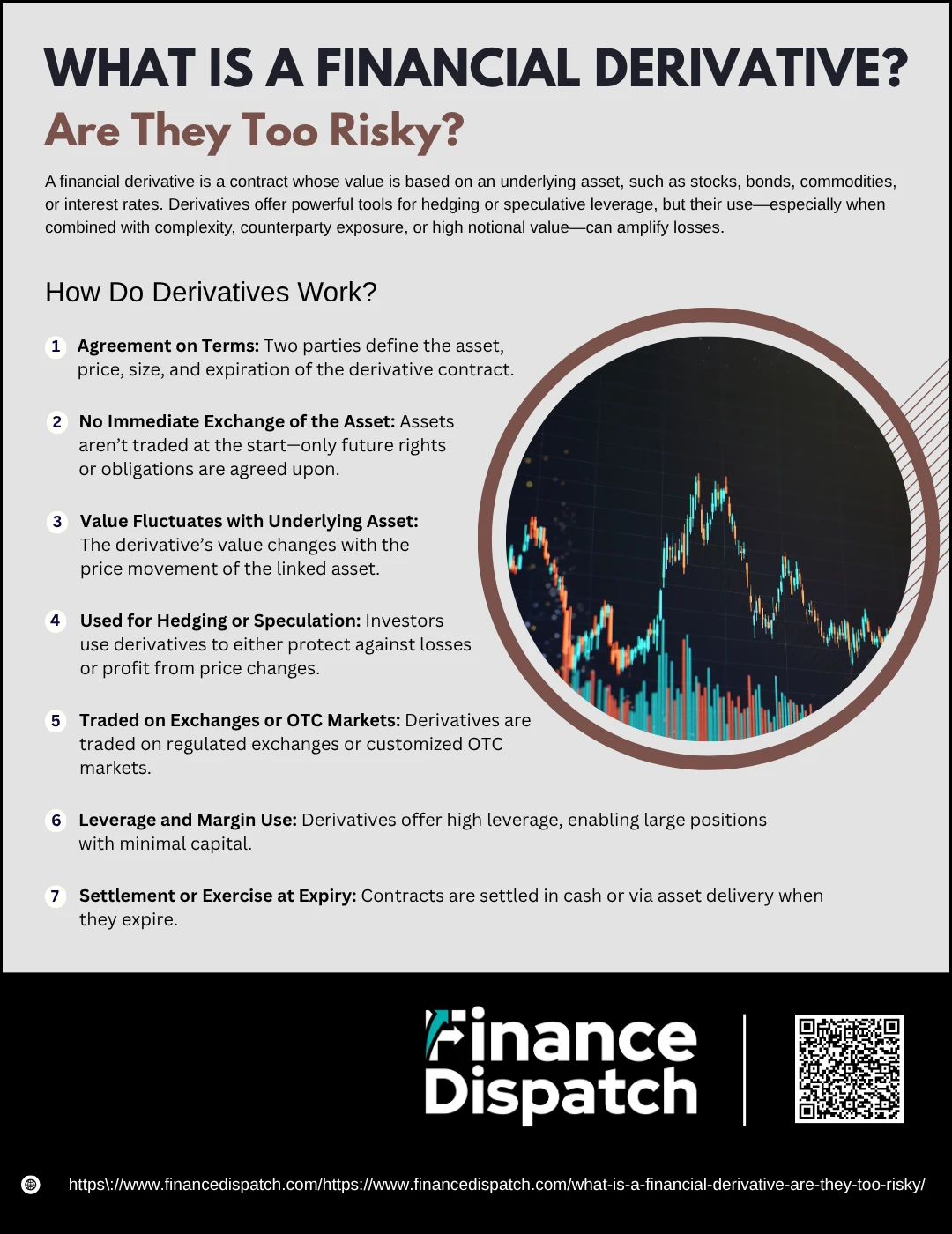Financial derivatives are among the most powerful and versatile tools in modern finance—yet they often spark confusion and concern. At their core, derivatives are contracts whose value is tied to the performance of an underlying asset, such as stocks, commodities, currencies, or interest rates. While they offer opportunities to hedge risk, enhance returns, and access otherwise unreachable markets, derivatives also carry significant potential for loss and complexity. This article explores what financial derivatives are, how they work, and whether their benefits truly outweigh their risks.
What is a Financial Derivative?
A financial derivative is a contract whose value is based on the performance of an underlying asset, index, or benchmark. These underlying assets can include commodities, stocks, bonds, currencies, interest rates, or market indexes. Derivatives are essentially agreements between two or more parties and can be traded either on regulated exchanges or over-the-counter (OTC) markets. Their primary purpose is to manage risk or gain exposure to specific financial instruments without owning them directly. Because the value of derivatives fluctuates with the underlying asset, they are used for strategies such as hedging against losses or speculating on future price movements
 How Do Derivatives Work?
How Do Derivatives Work?
Derivatives are financial instruments designed to derive their value from the performance of an underlying asset, such as a commodity, stock, interest rate, or currency. Instead of directly trading the asset, investors use derivatives to speculate on or hedge against changes in its price. Here’s a step-by-step breakdown of how derivatives function in real-world scenarios:
1. Agreement on Terms
Two parties enter into a contract that specifies crucial terms: the underlying asset, the price at which the asset will be valued, the contract size, and the expiration date. This agreement sets the foundation for future obligations, whether it’s buying, selling, or exchanging cash flows. In standardized derivatives like futures and options, these terms are predefined by the exchange. In over-the-counter (OTC) derivatives, parties have the flexibility to tailor the terms.
2. No Immediate Exchange of the Asset
When a derivative contract is created, the actual asset (such as barrels of oil or company shares) is not exchanged. Instead, both parties agree to transact in the future under the contract’s terms. This allows investors to gain exposure to an asset’s price movements without needing to own or store it.
3. Value Fluctuates with Underlying Asset
The derivative’s price moves in tandem with the underlying asset. For example, if the price of gold increases, a gold futures contract will also rise in value. This sensitivity is what makes derivatives powerful tools for both protection and profit—any gain or loss depends directly on the market performance of the underlying asset.
4. Used for Hedging or Speculation
One of the most common uses of derivatives is hedging, where businesses or investors use them to protect against potential losses. For example, a wheat farmer might use futures to lock in a selling price months before harvest. On the other hand, speculators use derivatives to bet on price movements, aiming to profit from market volatility without holding the actual asset.
5. Traded on Exchanges or OTC Markets
Derivatives can be traded on organized exchanges or privately negotiated over-the-counter. Exchange-traded derivatives (like futures and options) are standardized, regulated, and cleared through intermediaries—offering more security and transparency. OTC derivatives (like most swaps and forwards) are customized but carry higher counterparty risk due to the lack of a clearinghouse.
6. Leverage and Margin Use
Derivatives often require only a fraction of the asset’s total value as collateral (called margin), making them highly leveraged. This means investors can control a large market position with relatively little capital. While leverage amplifies potential gains, it also increases the risk of substantial losses if the market moves against the investor’s position.
7. Settlement or Exercise at Expiry
When the derivative contract expires, it is either settled in cash or involves the delivery of the underlying asset. In cash-settled contracts, profits or losses are calculated based on the asset’s market price at expiration, and the net amount is credited or debited. In physically settled contracts, one party must deliver the asset, and the other must accept it as agreed.
Types of Financial Derivatives
Financial derivatives come in several forms, each serving unique purposes in risk management, speculation, and portfolio enhancement. These instruments are tailored to meet different needs depending on whether the trader seeks to hedge potential losses, leverage capital, or gain exposure to specific markets. Despite their complexity, the four main types of derivatives—futures, forwards, swaps, and options—form the backbone of this vast and evolving financial landscape.
1. Futures Contracts
A futures contract is a standardized agreement between two parties to buy or sell an asset at a predetermined price on a specified future date. These contracts are traded on regulated exchanges and are commonly used for hedging or speculating on the price movement of assets like commodities, currencies, or financial indexes. The buyer and seller are both obligated to fulfill the terms of the contract at expiration, regardless of the market price at that time.
2. Forward Contracts
Similar to futures, forward contracts involve an agreement to buy or sell an asset at a set price in the future. However, forwards are traded over-the-counter (OTC), making them customizable in terms of contract size, expiration, and asset type. This flexibility comes with higher counterparty risk, as there’s no exchange acting as a guarantor between the two parties.
3. Swaps
Swaps are private contracts where two parties agree to exchange cash flows or other financial instruments over time. The most common types include interest rate swaps, where parties exchange fixed and floating rate payments, and currency swaps, which involve exchanging principal and interest payments in different currencies. Swaps are primarily used by institutions to manage interest rate exposure, currency risk, or credit risk.
4. Options Contracts
Options give the buyer the right—but not the obligation—to buy (call option) or sell (put option) an underlying asset at a specified price before or on a certain date. Unlike futures and forwards, options provide flexibility and limit potential losses to the premium paid for the contract. These are widely used for hedging risk or betting on market volatility and are available in American and European styles, based on when they can be exercised.
 Are Financial Derivative Too Risky?
Are Financial Derivative Too Risky?
Financial derivatives are powerful tools, but their complexity and potential for high leverage often raise concerns. While they can help investors manage risk, they can also magnify losses and trigger financial instability if not handled properly. Understanding the key risks involved is essential for anyone considering these instruments. Below are the major reasons why financial derivatives are considered risky:
1. Leverage Amplifies Losses
Derivatives often require only a small margin to control large positions. This leverage can produce high returns but also results in equally large losses if the market moves against the position—even small price changes can have massive financial consequences.
2. Counterparty Risk in OTC Markets
In over-the-counter (OTC) derivatives, contracts are privately negotiated. This opens the door to counterparty risk—the possibility that the other party in the contract may default on their obligation, especially in volatile or crisis conditions.
3. Market Volatility and Price Fluctuations
Derivatives are highly sensitive to changes in the price of the underlying asset. Sudden market movements can quickly erode or eliminate the value of a derivative, especially if the position is not properly hedged.
4. Complexity and Lack of Transparency
Many derivatives involve complicated pricing models and contractual terms that can be difficult for non-experts to understand. This complexity increases the risk of misuse, mispricing, and poor decision-making.
5. Systemic Risk and Financial Crises
Improper or excessive use of derivatives has historically contributed to financial meltdowns. For example, the 2008 financial crisis was intensified by the misuse of credit default swaps, a type of derivative that spiraled into a cascade of defaults.
6. Regulatory Challenges
Although regulatory reforms have improved oversight, the global derivative market remains vast and intricate. Gaps in regulation can leave room for manipulation, inadequate disclosures, and insufficient risk controls.
Practical Uses of Financial Derivative
Financial derivatives are not just abstract financial instruments—they play a vital role in everyday financial management for businesses, investors, and institutions. These contracts are widely used to protect against risk, gain market exposure, and enhance investment strategies. Below are some of the most common and practical applications of financial derivatives in the real world:
1. Hedging Against Price Volatility
Companies use derivatives like futures and options to lock in prices for raw materials or currencies, protecting themselves from adverse price movements and ensuring cost predictability.
2. Speculating for Profit
Traders and investors use derivatives to bet on future price movements of assets like oil, gold, or stocks, aiming to profit from short-term market trends without owning the asset itself.
3. Managing Interest Rate Risk
Financial institutions often use interest rate swaps to convert variable-rate debt into fixed-rate obligations, helping them stabilize interest expenses and manage financial planning.
4. Currency Risk Mitigation
Multinational corporations use currency forwards and swaps to protect earnings from unfavorable fluctuations in foreign exchange rates when dealing with cross-border transactions.
5. Portfolio Diversification
Derivatives provide access to markets or asset classes that might be difficult or expensive to invest in directly, such as commodities or international indexes.
6. Enhancing Investment Returns through Leverage
By using derivatives like options and futures, investors can control large positions with relatively small amounts of capital, potentially amplifying returns—though with higher risk.
Advantages and Disadvantages of Financial Derivative
Financial derivatives offer numerous benefits, particularly in managing risk and enhancing portfolio flexibility. However, they also come with significant downsides due to their complexity, leverage, and market sensitivity. Understanding both sides is crucial before incorporating derivatives into an investment strategy. The table below outlines the key advantages and disadvantages of using financial derivatives:
| Advantages | Disadvantages |
| Risk Management | High Leverage Risk |
| Derivatives help hedge against price fluctuations in commodities, currencies, interest rates, and stocks. | Leverage can magnify both gains and losses, making trades highly risky. |
| Price Lock-In | Complexity and Mispricing |
| Contracts like futures and forwards allow firms to lock in prices, aiding in financial planning. | Complex valuation models make derivatives difficult to understand and accurately price. |
| Market Access | Counterparty Risk |
| Derivatives enable exposure to markets or assets that might otherwise be inaccessible. | In OTC contracts, there’s a risk the other party may default on the agreement. |
| Portfolio Leverage | Liquidity and Volatility Issues |
| Traders can control large positions with minimal capital, maximizing potential returns. | Derivatives can be illiquid and highly sensitive to market sentiment. |
| Improved Market Efficiency | Systemic Risk |
| By contributing to price discovery, derivatives enhance the overall efficiency of financial markets. | Poor oversight or misuse of derivatives can trigger broad financial instability. |
Who Uses Derivatives?
Derivatives are widely used by a diverse group of market participants, each with different objectives ranging from reducing financial risk to seeking profit from price movements. Whether it’s a multinational corporation hedging currency exposure or a hedge fund aiming to amplify returns, derivatives offer tailored solutions for various financial strategies. Below are the main types of users in the derivatives market:
1. Hedgers
Risk-averse participants like businesses and investors use derivatives to protect against price volatility in commodities, currencies, interest rates, or stock values.
2. Speculators
Traders and investors who seek to profit from anticipated changes in market prices without owning the underlying assets. They accept higher risks for potentially higher returns.
3. Arbitrageurs
These professionals exploit price differences of the same asset in different markets by simultaneously buying low and selling high, often using derivatives to lock in profits.
4. Institutional Investors
Pension funds, insurance companies, and asset managers use derivatives for portfolio management, hedging large positions, and enhancing returns.
5. Banks and Financial Institutions
These entities create, trade, and manage a large share of derivative contracts to manage interest rate risk, credit exposure, and liquidity.
6. Exporters and Importers
Businesses involved in international trade use currency derivatives to protect against unfavorable foreign exchange rate movements.
Conclusion
Financial derivatives are powerful instruments that serve a wide range of purposes, from hedging against risk to enabling speculative opportunities. While they offer flexibility, market access, and potential for high returns, they also carry significant risks—especially when leverage, complexity, and counterparty exposure are involved. Whether used by corporations, investors, or financial institutions, derivatives demand a clear understanding and responsible management. For those who approach them with caution and knowledge, derivatives can be valuable tools; for others, they may prove too risky without proper safeguards in place.



